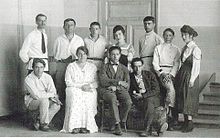Nikolai Mikhailovich Suetin
Nikolai Mikhailovich Suetin ( Russian Николай Михайлович Суетин ;. Scientific transliteration Nikolai Mikhailovich Suetin ; born October 25 . Jul / 6. November 1897 greg. In Mjatlewo ; † 22. January 1954 in Leningrad ) was a Russian artist of Suprematism . He worked as a painter, graphic artist, designer, book illustrator and porcelain painter.
Life
Nikolai Suetin was born on October 25th . / November 6, 1897 greg. Born in Mjatlewo near Kaluga .
Suetin's interest in drawing began while studying at a military school. His favorite artists at the time were Michail Wrubel and Mikalojus Čiurlionis . He joined the army at the beginning of the First World War .
Suetin studied art in Vitebsk from 1918 . At the beginning of 1919 he met Ivan Puni , in November 1919 Kazimir Malevich . In 1920 he was a founding member of UNOWIS . During this time he created a series of works that analyze the transition from Cubism to Suprematism. Together with other artists, he designed festival decorations in Vitebsk and designed signs, decorations for cafes, shop windows and speaker's stands. After completing his studies, he went to Petrograd with Malevich in 1922 . At the end of 1922 he began to work as a porcelain painter for the State Porcelain Manufactory . 1923-24 he exhibited with UNOWIS at the exhibition "Petrograd artists of all tendencies". During this time he created so-called “Architektona” and “Planiten”. In 1925 he headed the "Department for General Ideology" at GINChUK .
Suetin's porcelain works were shown at numerous exhibitions, for example at the Exposition Internationale des arts décoratifs et industriels modern in Paris in 1925. From 1927–30 he worked at the experimental laboratory of the Petrograd Institute for Art History. There he dealt with the connection between color and architecture. In addition, he created furniture. Some designs from this period were created in collaboration with Ilya Tschaschnik .
In the late 1920s he married Anna Leporskaja . He worked with her in the 1930s and 1940s on various exhibitions. From 1932 he was artistic director of the Lomonossow State Porcelain Manufactory. In 1932 he exhibited in Leningrad at the exhibition “Artists of the RSFSR in the last fifteen years”. In 1935 he designed the tombstone for Kasimir Malevich in Nemtschinowka , which no longer exists today.
He designed the pavilion of the USSR at the Paris World Exhibition of 1937 and the World Exhibition in New York in 1939 . In 1941 he exhibited in Moscow at the commemorative exhibition on the occasion of Mikhail Lermontov's 100th birthday, and in Leningrad in 1944-49 on the “The Heroic Defense of Leningrad”.
Suetin died in Leningrad on January 22, 1954.
literature
- Nikolai Suetin: 1897-1954. The State Russian Museum. Palace Editions, [Bad Breisig]; RA, [Moscow] 2008, ISBN 978-3-940761-00-2 .
- Suprematism: Works by Kasimir S. Malewitsch, Nikolaj M. Suetin, Ilja G. Tschaschnik from the Lew Nussberg archive, Orange, USA. Exhibition from May 30th to September 10th 1989. Galerie & Edition Schlégl, Zurich 1989. (catalog).
Individual evidence
- ↑ a b c d e f The great utopia. The Russian avant-garde 1915–1932 . Schirn Kunsthalle, Frankfurt am Main 1992, p. 773 .
Web links
- Literature by and about Nikolai Michailowitsch Suetin in the catalog of the German National Library
| personal data | |
|---|---|
| SURNAME | Suetin, Nikolai Michailowitsch |
| ALTERNATIVE NAMES | Суе́тин, Никола́й Миха́йлович (Cyrillic script); Suetin, Nikolaj Michajlovič (scientific transliteration) |
| BRIEF DESCRIPTION | Russian artist of Suprematism |
| DATE OF BIRTH | November 6, 1897 |
| PLACE OF BIRTH | Myatlevo |
| DATE OF DEATH | January 22, 1954 |
| Place of death | Leningrad |


